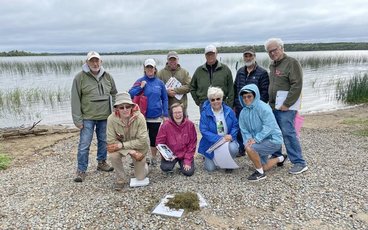
Starry stonewort search completed on 18 lakes in northern Hubbard County
Eleven volunteers from our lakes area trained for an hour on Aug. 21 at the DNR Wolf Lake Management Area undeveloped access on the border of Beltrami and Hubbard counties, where Starry Stonewort (SSW) was discovered during Starry Trek 2018.
The aquatic vegetation piled in front of the team on the viewing sheets is SSW retrieved in one rake toss.
We learned to identify the algae SSW with its grass-like appearance, smooth, thin stems with branchlets in whorls of 5 to 8. We looked, specifically, for uneven forked tips of the branchlets, too, and any presence of star-shaped bulbils on clear rhizoids, like fishline.
We compared it to the smaller, native lookalikes: chara, nitella, sago pondweed and water stargrass.
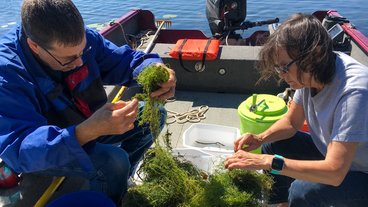
More Questions Than Answers For Starry Stonewort In Minnesota
PAYNESVILLE – Last year’s discovery of starry stonewort in Lake Koronis has made the lake our starting point for learning how to manage this new aquatic invasive species in Minnesota.
And learn we must. “There are more questions than answers for starry stonewort,’’ said Dan Larkin, assistant professor with the University of Minnesota Aquatic Invasive Species Research Center in the Twin cities.
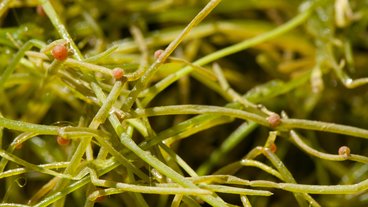
Volunteers needed Aug. 21 to help search for invasive species in Lake Minnetonka
Leaders with the Lake Minnetonka Conservation District are inviting community members meet Saturday, Aug. 21, at Excelsior Commons, 135 Lake Street, for a day of searching for starry stonewort and other aquatic invasive species.
The Starry Trek event is meant to be a fun and rewarding way to help protect Lake Minnetonka and other waters throughout the state for future generations.
Starry Trek is an annual event where members of the public first gather at training sites to learn how to identify starry stonewort and other aquatic invasive species. The newly trained citizen scientists then branch out to local water accesses to search for signs of the invasive species. In 2020, 212 volunteers scoured 292 public water accesses on 238 waterbodies across the state.
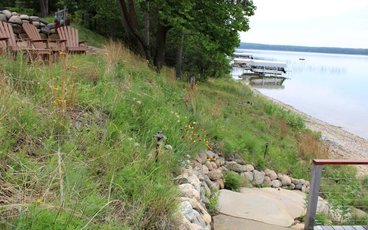
Shoreland advisors partner to improve water quality
Your friendly, neighborhood shoreland advisor is eager to team up with you to protect and improve water quality.
Sponsored by the Hubbard County Coalition of Lake Associations (COLA), the shoreland advisor program is a collaboration with Hubbard County University of Minnesota Extension and Hubbard County Soil and Water Conservation District (SWCD).
The goal is to protect area lakes and rivers by pairing trained, volunteer advisors with property owners. Together, they explore alternative lawn, gardening and lake-friendly, best management practices.
The program is voluntary, a short-term commitment and free.
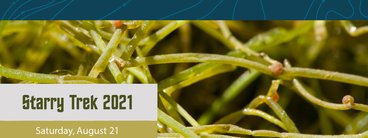
Stopping Starry stonewort
Looking for a fun opportunity to get outside, explore local lakes, and be a part of the solution to aquatic invasive species problems this summer? Starry Trek is the event for you! Starry Trek is an annual event hosted by the Minnesota Aquatic Invasive Species Research Center and University of Minnesota Extension in partnership with the Minnesota Department of Natural Resources. This event takes aim at searching for new populations of starry stonewort, invasive algae first discovered in Minnesota in 2015.
What to expect at Starry Trek
No experience is necessary to participate in Starry Trek and this is a free, family-friendly event. On the morning of August 21st, you'll arrive at the local training site you registered for. There you will be greeted by your local coordinator from one of our many local partners that make this event happen. You'll sign in to the event and receive a brief, on-site training. After your training, your coordinator will give you the equipment you need and assign you your monitoring route.
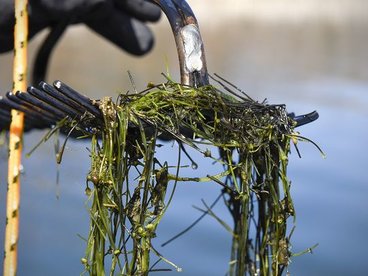
University Of Minnesota Extension Starry Trek: Explore Local Lakes And Help Find Aquatic Invasive Species On August 21
Looking for a fun opportunity to get outside, explore local lakes, and be a part of the solution to aquatic invasive species problems this summer? Starry Trek is the event for you! Starry Trek is an annual event hosted by the Minnesota Aquatic Invasive Species Research Center and University of Minnesota Extension in partnership with the Minnesota Department of Natural Resources. This event takes aim at searching for new populations of starry stonewort, invasive algae first discovered in Minnesota in 2015.
What to expect at Starry Trek
No experience is necessary to participate in Starry Trek and this is a free, family-friendly event. On the morning of August 21st, you'll arrive at the local training site you registered for. There you will be greeted by your local coordinator from one of our many local partners that make this event happen. You'll sign in to the event and receive a brief, on-site training.
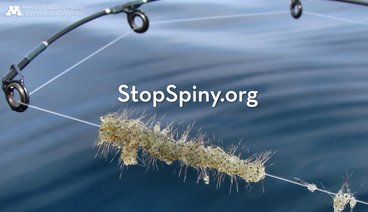
Minnesota Aquatic Invasive Species Research Center launches spiny water flea campaign
The spiny water flea, a small opaque zooplankton that is becoming a threat to Minnesota waters, is the subject of a new campaign by the Minnesota Aquatic Invasive Species Research Center.
This invasive species disrupts the natural food chain by devouring the micronutrients that sustain and grow native fish species, yet offer no nutritional value themselves. Once established in a lake there is no treatment, chemical or otherwise, that will eradicate them, a release said.
As a result, the MAISRC has launched a campaign called Stop Spiny, which is aimed at educating Minnesotans about spiny water fleas, their spread and how to stop them.
Bruce Anspach, a Beltrami County aquatic invasive species lakes technician, is supporting the campaign and looking to educate those in Beltrami County about it.
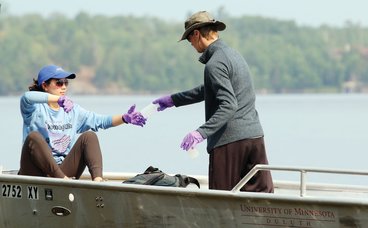
Tracking AIS through DNA
REGIONAL— Researchers from the Natural Resources Research Institute were on Lake Vermilion this week as they work to refine a high-tech testing method that could eventually make the hunt for aquatic invasive species, or AIS, far more efficient and effective. They’re getting logistical help with the project from the Vermilion Lake Association, which has long played a major role in heading off AIS on the lake.
“Everything that lives in the lake releases some DNA,” said Josh Dumke, a senior research scientist at the NRRI, which is affiliated with the University of Minnesota-Duluth. Whether plant or animal, tissue cells containing DNA are regularly sloughed off into the water, Dumke said, either through skin cells, mucous, or urine. That means, in theory, that water samples from a lake could eventually help researchers detect the presence of AIS far more effectively than current methods, particularly on large lakes like Vermilion.

Local volunteers needed to search for starry stonewort, other lake invasives
Starry Trek volunteers have found starry stonewort in several lakes, including Wolf Lake at the Hubbard-Beltrami county line and Lake Beltrami in Beltrami County.
Lake-loving volunteers are needed across Minnesota on Saturday, Aug. 21, to participate in a search for starry stonewort — an aggressive, aquatic invasive algae that spreads easily and grows into dense mats at and below the lake’s surface.
Starry Trek is an annual event where members of the public first gather at training sites to learn how to identify starry stonewort and other aquatic invasive species. The newly trained citizen scientists then branch out to local water accesses to search for signs of the invasive species.
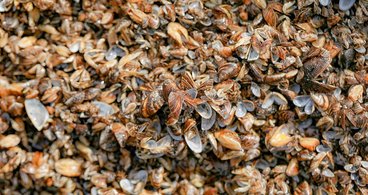
Scientists study the genetics of invasive mussels seeking ways to turn off the genes that allow them to spread and survive
In Lake Michigan, mussels face divers ready to scrape them off rocks, molluscicides pumped underwater capable of tearing apart their digestive systems, another invasive species hungry for their young and any number of death traps researchers dream up next.
Throughout the country, scientists are studying a range of control methods to uproot invasive mussels, hoping that — like the threads that glue the mollusks down — something eventually sticks.
